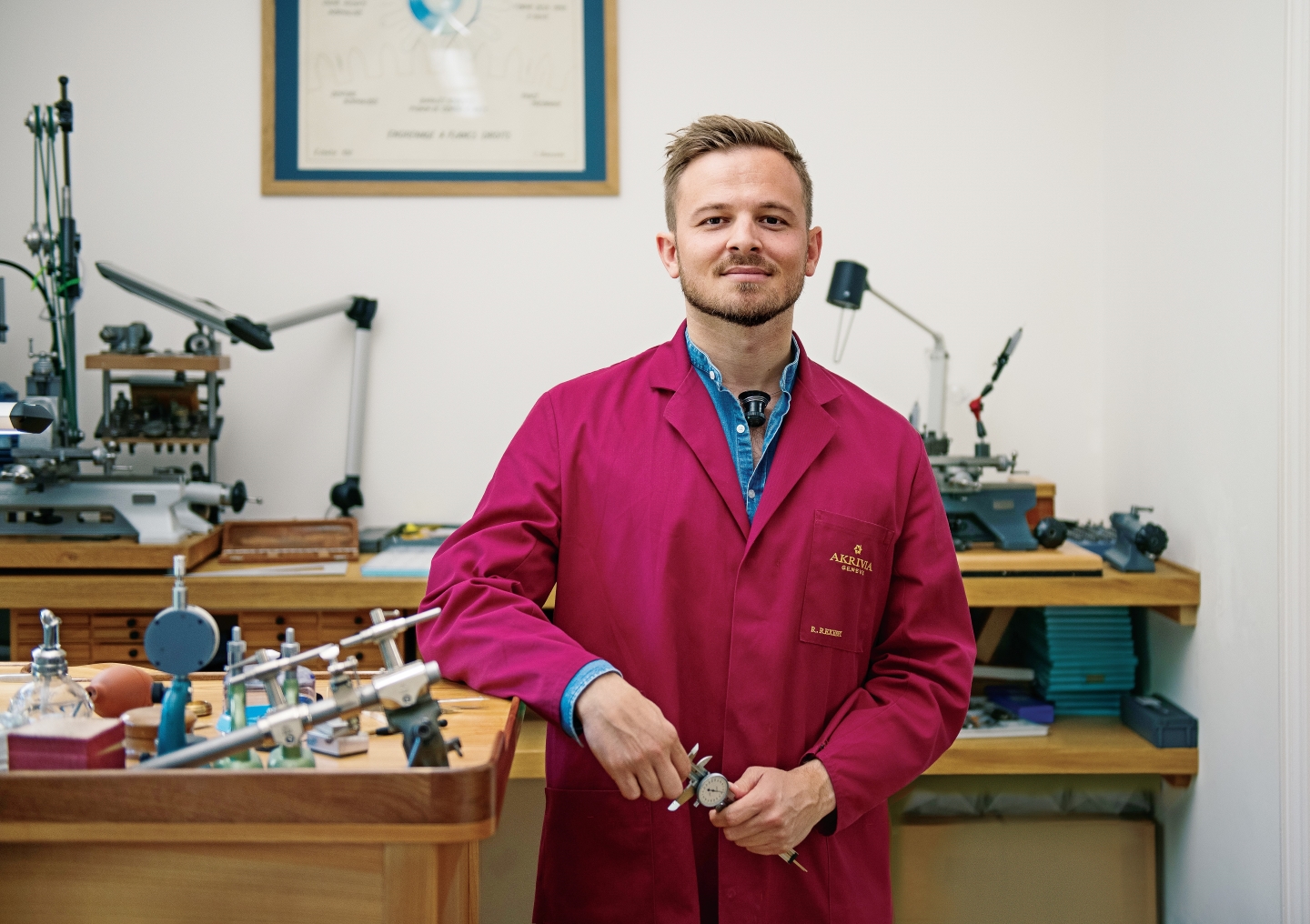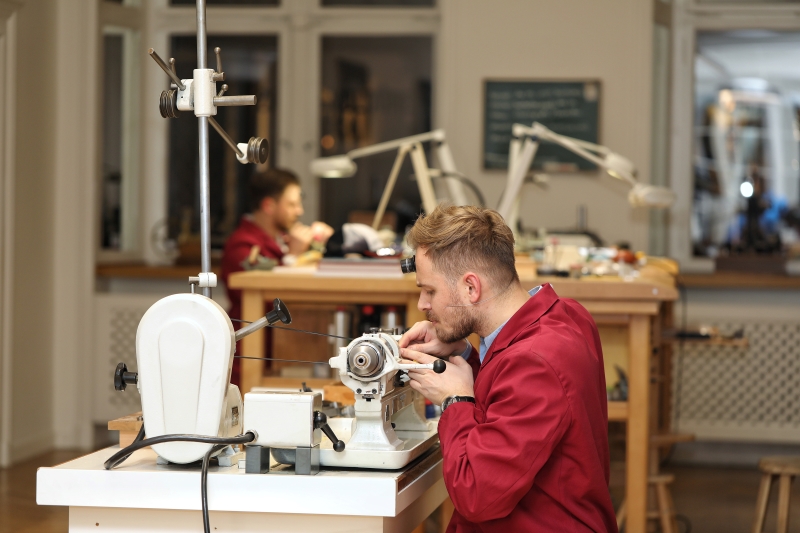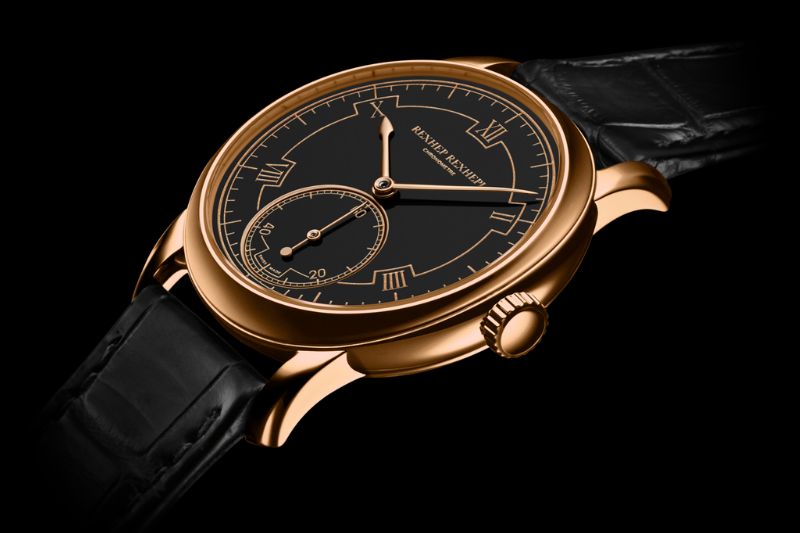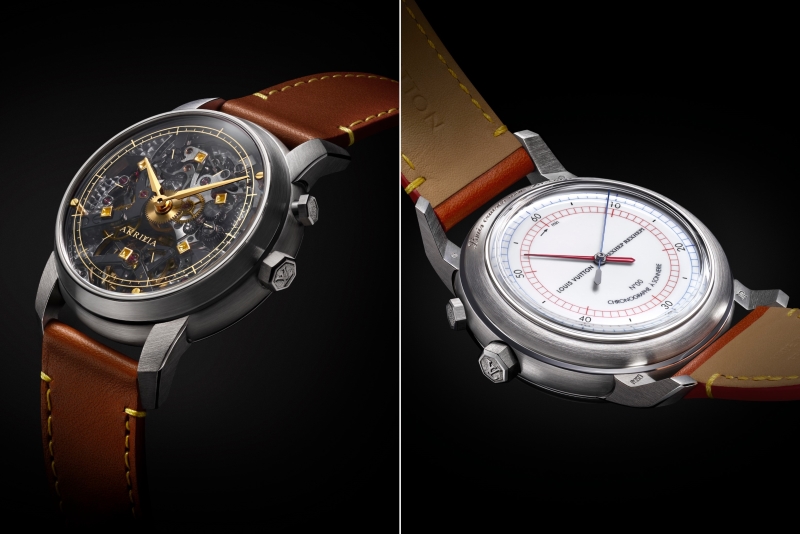
Rexhepi has accomplished much in a handful of years but insists there is still much to do (All photos: Akrivia)
On a crisp spring morning, Rexhep Rexhepi, founder of Akrivia, treads up a cobblestoned street in Geneva’s Old Town, Switzerland. He fishes around his pocket for his keys and unlocks the door to his atelier, playfully apologising for the untidiness inside. In reality, it looks like a space well lived with none of the “mess” he was talking about. After all, aside from being a place where his small team would come in for tea and discussions, it is also where Akrivia’s timepieces are showcased to guests and collectors, many of whom are esteemed and well heeled.
A 2019 New York Times article about the brand is framed on a wall alongside a design sketch of a workbench and a photo of a nondescript pocket watch reminiscent of the Patek Philippe ref. 973J. Emblazoned with his own name over where the original logo should have been is actually the school watch Rexhepi assembled during his apprenticeship at Patek Philippe, where he started at just 15 years old.
After five years, he moved to BNB Concept and was helming a team of movement specialists, some decades his senior, at the height of his three-year tenure. Rexhepi later joined FP Journe for a little over a year before striking out on his own. In 2012, he established his company at the age of 25 — out of his small apartment, it must be said.
Akrivia stands for “precision” in Greek, but the brand is perhaps best known for its impeccable artisanal work and exceptional hand finishes. Rexhepi has a soft spot for tourbillons, which is why he christened the brand with one.
“My dream was about having something that’s animated,” he recalls. “I remember the first time I saw this particular watch. It was a 10 Day Tourbillon from Patek Philippe. I was 16. I looked at it for 45 minutes and thought, wow, this is what I want to have in my life. To build movements and watches that correspond to me and my values.”
swisswatches-akrivia-workshop.jpg

The AK-01 Tourbillon Chronographe Monopoussoir was an ambitious endeavour. At the time, it seemed like a good idea, instinctual even, to present something that would demonstrate his range of skills and abilities. The watch needed to make a statement and stand out from the rest, so it took on an elaborate aesthetic. It was an “emotional” experience launching the complication, Rexhepi shares. He was young and eager to prove himself. Akrivia’s early timepieces were variations that expressed his sentiments, but interest was low, which meant times were tough. However, Rexhepi also developed a heart for classic designs during his training at Patek Philippe. He would later realise that it was only when he followed his heart that doors would open.
Eventually, Rexhepi decided to design a watch that he would personally wear — something smaller, more discreet and, of course, classic. In 2018, he released the Chronomètre Contemporain RRCC I, but signed it with his own name instead of Akrivia — the same way he did with that pocket watch many years ago.
The move helped distinguish the timepiece from the main collection, but having his name on display also meant he could no longer hide behind the anonymity Akrivia provided. Rexhep Rexhepi, the watchmaker, the man behind the mechanics, was brought to the forefront, and those who had the honour of seeing the neo-classical watch first-hand at Baselworld would also notice that Rexhepi’s new creation carried a newfound honesty and sincerity.
The watch took on a round case, either rose gold or platinum, with a subtly concave bezel and curved bevelled lugs. A beautiful grand feu enamel dial displayed the hours, minutes and seconds. Anything superfluous was out the window when it came to design. Instead, the movement’s artisanal decorations that have since become a hallmark of the brand were highlighted. The reverse was given visual balance and a symmetrical touch, enhanced by a variety of fine finishes which can entrance even the most experienced eye.
chronometre_contemporain_rrcc_i.jpg

Feedback was overwhelmingly positive. That year, Rexhepi took home a Grand Prix d’Horlogerie de Genève (GPHG) statuette for the Men’s Watch Prize and his brand became a household name within watch collecting circles. But this was just the beginning.
The brand’s popularity continued to skyrocket in the coming years. Rexhepi began a partnership with case-maker and jeweller Jean-Pierre Hagmann, whose clients included Audemars Piguet, Vacheron Constantin and Patek Philippe. Hagmann had actually retired, but the craftsman returned to the scene to assist Akrivia in producing superlative cases to further its journey of exquisite watchmaking. A photo of the both of them occupies a space on that same wall in the atelier.
The workshop is right across the street (at press time, a third space is being constructed) and he introduces it as the place where he spends most of his time. “When you come here, there’s a different ‘smell’,” he says as he looks around the work benches strewn with both traditional and contemporary tools. This “smell” makes the workshop almost alchemic. As the handful of experts come in daily to work their magic, Rexhepi oversees from his own bench at the far end of the room.
“For me, every day I wake up, I’m happy to come here. I know it can be a challenge but I really do love what I do. And I’m happy just with my team. When you’re a watchmaker, you always have your own way of doing things and you believe other people won’t understand. But now I’m starting to see that it’s possible because of my team.”
The years following the launch of the Chronomètre Contemporain were marked by a number of milestones. The unique pieces Rexhepi created for the Only Watch charity auctions in 2019 and 2021 were wildly successful, with the latter hammering for a whopping CHF800,000. The second version of the Chronomètre Contemporain, the RRCC II, released last May, earned him his second GPHG Men’s Watch Prize. Just a few months ago, the brand made headlines for its collaboration with Louis Vuitton on the LVRR-01 Chronographe à Sonnerie, a handsome double-faced chronograph with a chiming complication.
akrivia_louis_vuitton.jpg

Rexhepi developed a completely new tourbillon movement from the ground up to be installed in a redesigned Louis Vuitton Tambour case, crafted by, of course, Hagmann. On the front, a smoke-tinted sapphire crystal showcases the inverted calibre, highlighting the tourbillon at six o’clock, which rotates once every five minutes, and the sonnerie’s expertly hand-finished chiming components. Take a closer look and you will see the “V” in Akrivia has been replaced with “LV”, marking the first time Louis Vuitton has combined its logo with that of another brand.
But the watch celebrates the Rexhep Rexhepi name too. On the other side, a glossy white grand feu enamel dial (crafted by Louis Vuitton’s in-house enameller) backgrounds two concentric tracks in blue and red that mark the running seconds and minutes of the chronograph. Elapsed time is indicated by a single, clear chime every minute, which adds a charming acoustic touch to the complication.
Rexhepi has accomplished much in a handful of years but insists there is still much to do. Demand is high, but the pieces are limited. With only 40 to 45 watches produced a year, he is often hounded by collectors, some of whom are willing to wait all their lives for the opportunity to purchase just one.
This discipline and gritty desire to continually push forward are perhaps the result of a turbulent past. A young Rexhepi fled his hometown to escape the Kosovo War, finding sanctuary in Switzerland where his father worked. In more peaceful times, whenever the latter visited, Rexhepi would tinker with the Swiss timepieces he brought home. So, when he arrived in the country to seek refuge, the calling was crystal clear.
Rexhepi is now 36 and a father of two, but does not intend to slow down. “I wish to continue evolving and learning. This is what I want to do. When you’re happy with the work, the next project you have to do better.” What will he have in store for us next, we wonder.
This article first appeared on Dec 18, 2023 in The Edge Malaysia.


